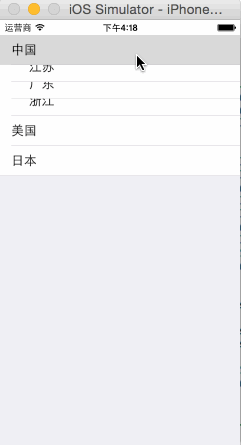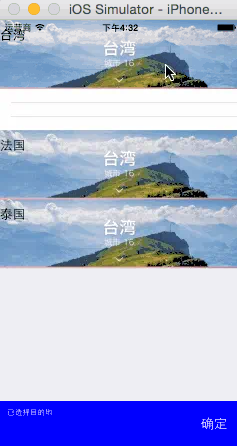一、简介
树形控件在多列列表、多级菜单中使用比较常见,比如:国家-省份-城市 多级选择、学校-专业-班级 多级选择等等。然而IOS自带控件中并不存在树形控件,我们要在IOS开发中使用树形控件,通常需要自己扩展UITableView列表控件。
现在在这里开源一个自己写的高扩展性,高复用性的IOS树形结构控件。
支持无限极树形结构。
使用的是非递归方式。
代码简单易懂,扩展方便。
图片演示如下:

二、使用说明
第一步:建立数据模型
parentId : 该节点的父控件id号,如果为-1则表示该节点为根节点
nodeId : 每个节点自身的id号,是每个节点的唯一标示
name : 节点的名称
depth : 该节点所带的树形结构中的深度,根节点的深度为0
expand : 该节点是否处于展开状态
/**
* 每个节点类型
*/
@interface Node : NSObject
@property (nonatomic , assign) int parentId;//父节点的id,如果为-1表示该节点为根节点
@property (nonatomic , assign) int nodeId;//本节点的id
@property (nonatomic , strong) NSString *name;//本节点的名称
@property (nonatomic , assign) int depth;//该节点的深度
@property (nonatomic , assign) BOOL expand;//该节点是否处于展开状态
/**
*快速实例化该对象模型
*/
- (instancetype)initWithParentId : (int)parentId nodeId : (int)nodeId name : (NSString *)name depth : (int)depth expand : (BOOL)expand;
@end
第二步:按照以上的数据模型,组装数据,下面以 国家-身份-城市 的三级目录进行演示。
//----------------------------------中国的省地市关系图3,2,1--------------------------------------------
Node *country1 = [[Node alloc] initWithParentId:-1 nodeId:0 name:@"中国" depth:0 expand:YES];
Node *province1 = [[Node alloc] initWithParentId:0 nodeId:1 name:@"江苏" depth:1 expand:NO];
Node *city1 = [[Node alloc] initWithParentId:1 nodeId:2 name:@"南通" depth:2 expand:NO];
Node *city2 = [[Node alloc] initWithParentId:1 nodeId:3 name:@"南京" depth:2 expand:NO];
Node *city3 = [[Node alloc] initWithParentId:1 nodeId:4 name:@"苏州" depth:2 expand:NO];
Node *province2 = [[Node alloc] initWithParentId:0 nodeId:5 name:@"广东" depth:1 expand:NO];
Node *city4 = [[Node alloc] initWithParentId:5 nodeId:6 name:@"深圳" depth:2 expand:NO];
Node *city5 = [[Node alloc] initWithParentId:5 nodeId:7 name:@"广州" depth:2 expand:NO];
Node *province3 = [[Node alloc] initWithParentId:0 nodeId:8 name:@"浙江" depth:1 expand:NO];
Node *city6 = [[Node alloc] initWithParentId:8 nodeId:9 name:@"杭州" depth:2 expand:NO];
//----------------------------------美国的省地市关系图0,1,2--------------------------------------------
Node *country2 = [[Node alloc] initWithParentId:-1 nodeId:10 name:@"美国" depth:0 expand:YES];
Node *province4 = [[Node alloc] initWithParentId:10 nodeId:11 name:@"纽约州" depth:1 expand:NO];
Node *province5 = [[Node alloc] initWithParentId:10 nodeId:12 name:@"德州" depth:1 expand:NO];
Node *city7 = [[Node alloc] initWithParentId:12 nodeId:13 name:@"休斯顿" depth:2 expand:NO];
Node *province6 = [[Node alloc] initWithParentId:10 nodeId:14 name:@"加州" depth:1 expand:NO];
Node *city8 = [[Node alloc] initWithParentId:14 nodeId:15 name:@"洛杉矶" depth:2 expand:NO];
Node *city9 = [[Node alloc] initWithParentId:14 nodeId:16 name:@"旧金山" depth:2 expand:NO];
//----------------------------------日本的省地市关系图0,1,2--------------------------------------------
Node *country3 = [[Node alloc] initWithParentId:-1 nodeId:17 name:@"日本" depth:0 expand:YES];
NSArray *data = [NSArray arrayWithObjects:country1,province1,city1,city2,city3,province2,city4,city5,province3,city6,country2,province4,province5,city7,province6,city8,city9,country3, nil];
第三步:使用以上数据进行TeeTableView的初始化。
1.TreeTableView *tableview = [[TreeTableView alloc] initWithFrame:CGRectMake(0, 20, CGRectGetWidth(self.view.frame), CGRectGetHeight(self.view.frame)-20) withData:data];
[self.view addSubview:tableview];
通过简单以上三步,你就可以把该树形控件集成到你的项目中。
三、实现原理
树形结构的列表用的其实就是UITableView控件,但是如何能够让UItableView能够动态的增加和删除指定的行数的cell是实现树形结构的关键所在。
这时候我们需要用到两个UItableView自带的行数:
- (void)insertRowsAtIndexPaths:(NSArray *)indexPaths withRowAnimation:(UITableViewRowAnimation)animation;
- (void)deleteRowsAtIndexPaths:(NSArray *)indexPaths withRowAnimation:(UITableViewRowAnimation)animation;
第一个函数用来在指定的位置插入cells,第二个函数用来在指定的位置删除cells,并且这二个函数都自带多种动画效果,让删除和插入的过程不至于太突兀、有种渐变的感觉,具有良好的用户体验。
对于这几个动画做了尝试:
UITableViewRowAnimationFade : 渐变效果
UITableViewRowAnimationRight : 右边进入,右边消失
UITableViewRowAnimationLeft : 左边进入,左边消失
UITableViewRowAnimationTop : 顶部进入,顶部消失
UITableViewRowAnimationBottom : 顶部进入,底部消失
注意点:
在调用insertRowsAtIndexPaths和deleteRowsAtIndexPaths的时候一定要先改变数据源,在调用上述函数,不然会产生crash。
接下来把TreeTableView的主要代码展示出来,因为本来代码量就不大,而且代码中注释也比较全,希望能够帮助大家理解。
#import "TreeTableView.h"
#import "Node.h"
@interface TreeTableView ()<UITableViewDataSource,UITableViewDelegate>
@property (nonatomic , strong) NSArray *data;//传递过来已经组织好的数据(全量数据)
@property (nonatomic , strong) NSMutableArray *tempData;//用于存储数据源(部分数据)
@end
@implementation TreeTableView
-(instancetype)initWithFrame:(CGRect)frame withData : (NSArray *)data{
self = [super initWithFrame:frame style:UITableViewStyleGrouped];
if (self) {
self.dataSource = self;
self.delegate = self;
_data = data;
_tempData = [self createTempData:data];
}
return self;
}
/**
* 初始化数据源
*/
-(NSMutableArray *)createTempData : (NSArray *)data{
NSMutableArray *tempArray = [NSMutableArray array];
for (int i=0; i<data.count; i++) {
Node *node = [_data objectAtIndex:i];
if (node.expand) {
[tempArray addObject:node];
}
}
return tempArray;
}
#pragma mark - UITableViewDataSource
#pragma mark - Required
-(NSInteger)tableView:(UITableView *)tableView numberOfRowsInSection:(NSInteger)section{
return _tempData.count;
}
- (UITableViewCell *)tableView:(UITableView *)tableView cellForRowAtIndexPath:(NSIndexPath *)indexPath{
static NSString *NODE_CELL_ID = @"node_cell_id";
UITableViewCell *cell = [tableView dequeueReusableCellWithIdentifier:NODE_CELL_ID];
if (!cell) {
cell = [[UITableViewCell alloc] initWithStyle:UITableViewCellStyleDefault reuseIdentifier:NODE_CELL_ID];
}
Node *node = [_tempData objectAtIndex:indexPath.row];
NSMutableString *name = [NSMutableString string];
for (int i=0; i<node.depth; i++) {
[name appendString:@" "];
}
[name appendString:node.name];
cell.textLabel.text = name;
return cell;
}
#pragma mark - Optional
- (CGFloat)tableView:(UITableView *)tableView heightForHeaderInSection:(NSInteger)section{
return 0.01;
}
- (CGFloat)tableView:(UITableView *)tableView heightForRowAtIndexPath:(NSIndexPath *)indexPath{
return 40;
}
- (CGFloat)tableView:(UITableView *)tableView heightForFooterInSection:(NSInteger)section{
return 0.01;
}
#pragma mark - UITableViewDelegate
#pragma mark - Optional
- (void)tableView:(UITableView *)tableView didSelectRowAtIndexPath:(NSIndexPath *)indexPath{
//先修改数据源
Node *parentNode = [_tempData objectAtIndex:indexPath.row];
NSUInteger startPosition = indexPath.row+1;
NSUInteger endPosition = startPosition;
BOOL expand = NO;
for (int i=0; i<_data.count; i++) {
Node *node = [_data objectAtIndex:i];
if (node.parentId == parentNode.nodeId) {
node.expand = !node.expand;
if (node.expand) {
[_tempData insertObject:node atIndex:endPosition];
expand = YES;
}else{
expand = NO;
endPosition = [self removeAllNodesAtParentNode:parentNode];
break;
}
endPosition++;
}
}
//获得需要修正的indexPath
NSMutableArray *indexPathArray = [NSMutableArray array];
for (NSUInteger i=startPosition; i<endPosition; i++) {
NSIndexPath *tempIndexPath = [NSIndexPath indexPathForRow:i inSection:0];
[indexPathArray addObject:tempIndexPath];
}
//插入或者删除相关节点
if (expand) {
[self insertRowsAtIndexPaths:indexPathArray withRowAnimation:UITableViewRowAnimationNone];
}else{
[self deleteRowsAtIndexPaths:indexPathArray withRowAnimation:UITableViewRowAnimationNone];
}
}
/**
* 删除该父节点下的所有子节点(包括孙子节点)
*
* @param parentNode 父节点
*
* @return 邻接父节点的位置距离该父节点的长度,也就是该父节点下面所有的子孙节点的数量
*/
-(NSUInteger)removeAllNodesAtParentNode : (Node *)parentNode{
NSUInteger startPosition = [_tempData indexOfObject:parentNode];
NSUInteger endPosition = startPosition;
for (NSUInteger i=startPosition+1; i<_tempData.count; i++) {
Node *node = [_tempData objectAtIndex:i];
endPosition++;
if (node.depth == parentNode.depth) {
break;
}
node.expand = NO;
}
if (endPosition>startPosition) {
[_tempData removeObjectsInRange:NSMakeRange(startPosition+1, endPosition-startPosition-1)];
}
return endPosition;
}
四、总结
在演示项目中,每个cell我都使用系统自带的cell,样式比较简单,如果你要展现更加漂亮的样式,可以自定义cell。
同时,你也可以扩展该数据模型,运动到更加复杂的业务处理中。比如以下场景:

五、下载地址
Demo下载地址:这是一个我的iOS交流群:624212887,群文件自行下载,不管你是小白还是大牛热烈欢迎进群 ,分享面试经验,讨论技术, 大家一起交流学习成长!希望帮助开发者少走弯路。
如果觉得对你还有些用,就关注小编+喜欢这一篇文章。你的支持是我继续的动力。
下篇文章预告:iOS开发UI篇--一个支持图文混排的ActionSheet
文章来源于网络,如有侵权,请联系小编删除。